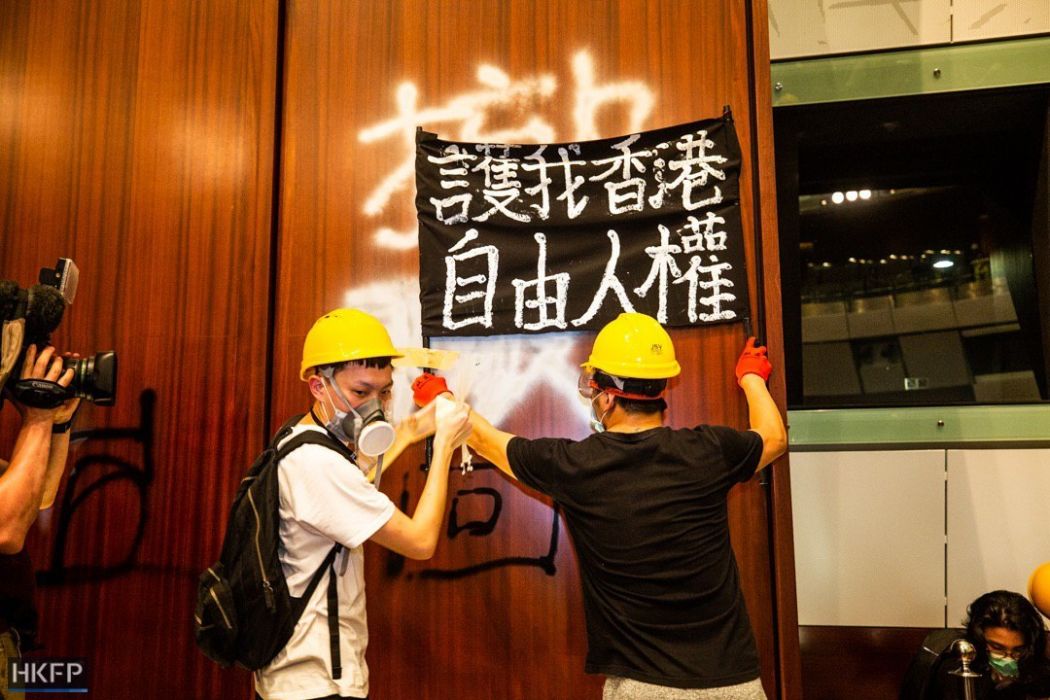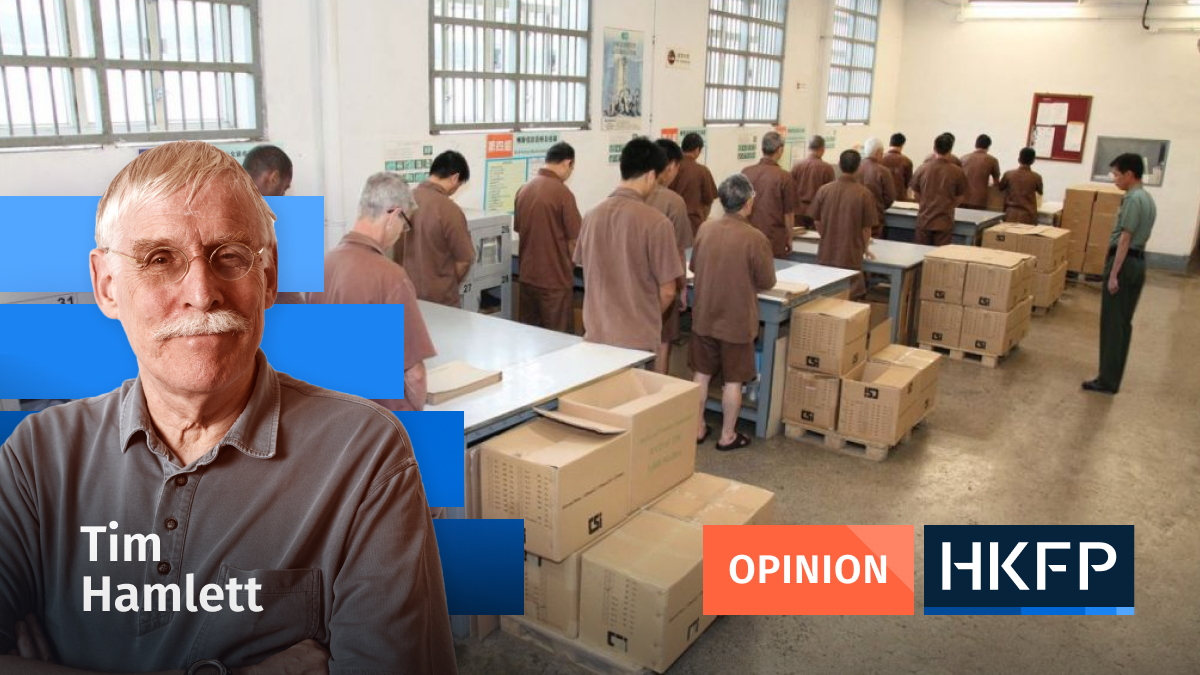Lazy social media juxtapositions for laughs and meme culture should have prepared us for this. But seeing it on repeat on our screens the day after 53 pro-democracy activists were arrested at 6 am on national security charges made it unbearable. And yet, there it was: a false equivalence between the Hong Kong storming of the Legislative Council (LegCo) on July 1, 2019, and the mob of Trump supporters laying siege to Capitol Hill on the day in which Congress was going to confirm Joe Biden’s presidential victory.
The visuals have hardly any parallels: one was an empty chamber, at night, entered by young protesters, mostly dressed in black and with yellow hard hats – most of whom had been taking part in mass demonstrations for months against a hated and ill-conceived extradition law. The government had been refusing all dialogue, ignoring peaceful marches of millions, hunger strikes and countless negotiators who had tried to bridge the divide. They didn’t loot, but sprayed political slogans with black paint – and they were masked, conscious of the dire consequences of their actions.
The other, a mostly white mass of protesters incited by a president who never won the popular vote and has failed to obtain re-election but still refuses to concede – all while spreading inflammatory lies and conspiracy theories. They carelessly picked things up – like the grinning man who strolled around with a podium – and paraded themselves unmasked, basking in their impunity.

We could define both as popular anger. However, the anger that led to the storming of LegCo in Hong Kong erupted after years of peaceful requests for meaningful universal suffrage (promised to Hongkongers by the Basic Law) led nowhere. Meanwhile, the anger of the MAGA crowd was because of an election they lost and their desire to overturn the result – through violence – now that more ballots have not gone their way.
Those who have decided that the Hong Kong protesters are the “enemies of the people” (as Chief Executive Carrie Lam famously said) quite predictably jumped on the very superficial parallels, and used them in the oldest propagandistic ways: discredit the opponents, and use a very specific moment in history in the US to try and vilify the whole of democracy as a form of government.
First, draw an illogical parallel, then, use it to say that this proves that your system of government is better, and that the violence and the repulsive symbols used in Washington – by extension of the illogical parallel – are what the Hong Kong protesters would want too.
Perversely, this turns an anti-democratic mob into the tool through which an anti-democratic government tries to discredit a pro-democracy protest, saying that – in fact – all protests are, in essence, a form of mob rule. It doesn’t stand up to scrutiny for a second, but that is not the point: the point is simply to win an argument – no matter how fallacious – and ridicule one’s opponents in the style of the “wolf warrior” diplomacy that is now the favourite mode of communication of the Chinese diplomatic service.
The images that will probably remain most imprinted in people’s memories from the US are that guy dressed up like a buffalo with a big horn on his head and dubious tattoos with extreme-right wing symbols on his body. Or the other man with his feet on House speaker’s Nancy Pelosi’s desk, and a smirk on his face. Or the other one parading the Confederate flag through the corridors, that symbol of racism and slavery. Impunity, pride in racial discrimination and white supremacy, and a sense of easy triumph fed by the wildest mendacities propagated online and via extreme right wing media outlets.
In Hong Kong there were no smirks. Every moment of the storming of LegCo had gravity and fear stamped on it, and a gloomy sense of despair. From the Chinese media, though, and from Chinese official Twitter accounts, the message kept being the same: look at the double standards the US has! Americans applaud lawlessness in Hong Kong but don’t like it if it comes to the US! What goes around comes around. Schadenfreude is so satisfying.
The message, of course, is once again primarily for the domestic audience, long fed an asymmetrical news diet where anything bad that may happen in Western democracies is given plenty of space, in order to present a flattering mirror on China, where news on any national crisis is kept under tight control. Normally, propagandists have to work a little bit harder to make their points. This time, all it took was an image copy and paste and a lot of bad faith, to draw together incongruous parallels.

What matters of course is the timing, and the fact that all this has Hong Kong as a background. The city where promises of a “high degree of autonomy” have not been kept, and where – just the day before the Washington unrest – a repressive law saw 53 people who had tried to play by the rules arrested. Each were simply trying to enter that same legislative chamber that had earlier been stormed.
We have been told that they were putting together an “evil plan” by trying to win elections and maximise the role of the opposition and – the day after – as a commentary to the events in Washington, that democracy only leads to chaos. That this is not true – and that the two events are really very unlike each other – once again matters very little, as the world of propaganda is just a world of make-believe.
Support HKFP | Policies & Ethics | Error/typo? | Contact Us | Newsletter | Transparency & Annual Report | Apps
| HKFP is an impartial platform & does not necessarily share the views of opinion writers or advertisers. HKFP presents a diversity of views & regularly invites figures across the political spectrum to write for us. Press freedom is guaranteed under the Basic Law, security law, Bill of Rights and Chinese constitution. Opinion pieces aim to point out errors or defects in the government, law or policies, or aim to suggest ideas or alterations via legal means without an intention of hatred, discontent or hostility against the authorities or other communities. |
Help safeguard press freedom & keep HKFP free for all readers by supporting our team

More HKFP OPINION:
HKFP has an impartial stance, transparent funding, and balanced coverage guided by an Ethics Code and Corrections Policy.
Support press freedom & help us surpass 1,000 monthly Patrons: 100% independent, governed by an ethics code & not-for-profit.










